A Review of Resilience Assessment and Recovery Strategies of Urban Rail Transit Networks
Abstract
:1. Introduction
2. Construction of the Urban Rail Transit Network Model Based on Complex Network Theory
2.1. Characteristics of the Urban Rail Transit Network
2.2. Construction Method of the Urban Rail Transit Network Model
3. Assessment of the Resilience of Urban Rail Transit Networks
3.1. Development and Connotation of Resilience Theory
3.2. Resilience Measurement Method of the Urban Rail Transit Network
3.2.1. Based on the Resilience Performance Curves
3.2.2. Based on the Resilience Performance Characterization
3.3. Assessment Index of Urban Rail Transit Network Resilience
3.3.1. Network Topology
3.3.2. Passenger Travel Service
4. Failure Scenarios and Recovery Strategies of the Urban Rail Transit Network
4.1. Failure Scenarios of the Urban Rail Transit Network
4.2. Urban Rail Transit Network Recovery Strategy
5. Discussion
- The construction of an urban rail network model based on complex network theory serves as the foundation for conducting research on rail resilience. The existing Space L and Space P methods cannot simultaneously reflect the actual network topological structure and its transfer properties. Therefore, subsequent research should consider the heterogeneity among different lines and transfer properties to build a model that more accurately represents these characteristics. This will enhance the practical application value of the research results.
- The selection of appropriate assessment indexes and metrics is crucial for evaluating urban rail transit resilience. Most existing research on resilience in urban rail transit networks has utilized methods such as the resilience triangle and performance integral ratio for quantitative analysis. However, there is no unified standard among scholars for selecting performance response function indices, leading to deviations in analysis results. In subsequent research, it would be prudent to begin with the definition of urban rail transit network resilience and then select a comprehensive set of indicators that can simultaneously reflect both the network topology structure and passenger travel services.
- The recovery strategy should be developed based on the actual operational characteristics of urban rail transport. Currently, many studies on the recovery strategy of urban rail transit networks treat damaged stations or sections independently when determining the extent of failures. Few studies consider how urban rail transit management adjusts train operations across different stations and sections during disturbance events. This oversight neglects the interconnectedness of stations and intervals within the same operational segment of the rail transit system, resulting in a gap between study outcomes and real-world scenarios.
- The restoration of urban rail transit networks during disturbance events depends not only on recovery resources and the number of repair teams but also on the extent of damage to stations or intervals of the rail network and the repair capabilities of the teams. Most existing studies overlook the influence of these factors on recovery outcomes, with a few treating them as fixed values. Therefore, the focus of future research will be on how to incorporate the uncertainty of disruptive events into the study of repair strategies.
Author Contributions
Funding
Data Availability Statement
Acknowledgments
Conflicts of Interest
References
- Cao, X.; Xu, J.; Feng, D. Infrastructure Safety from the Perspective of Resilience Theory. Energies 2022, 15, 5778. [Google Scholar] [CrossRef]
- China Association of Metros. Urban Rail Transit 2022 Annual Statistics and Analysis Report. Available online: https://www.camet.org.cn/tjxx/11944 (accessed on 16 July 2024).
- Cao, X.; Feng, D.; Li, Y. Assessment of various seismic fragility analysis approaches for structures excited by non-stationary stochastic ground motions. Mech. Syst. Signal Process. 2023, 186, 109838. [Google Scholar] [CrossRef]
- Tang, H.; Zheng, J.; Li, M.; Shao, Z.; Li, L. Gauging the Evolution of Operational Risks for Urban Rail Transit Systems under Rainstorm Disasters. Water 2023, 15, 2811. [Google Scholar] [CrossRef]
- Ministry of Emergency Management of the People’s Republic of China. Zhengzhou, Henan “7-20” Extraordinarily Heavy Rainfall Disaster Investigation Report. Available online: https://www.mem.gov.cn/gk/sgcc/tbzdsgdcbg/202201/P020220121639049697767.pdf (accessed on 16 July 2024).
- Shanghai Observer. Shanghai Metro Apologizes! Line 11 Touch Network Failure Situation Description: No Fire, No Injuries, More Than 1300 Pas-Sengers Evacuated in an Orderly Manner. Available online: https://new.qq.com/rain/a/20221111A0A7WG00.html (accessed on 16 July 2024).
- Djalante, R.; Thomalla, F. Community Resilience to Natural Hazards and Climate Change Impacts: A Review of Definitions and Operational Frameworks. Asian J. Environ. Disaster Manag. 2011, 3, 339. [Google Scholar] [CrossRef]
- Strogatz, S.H. Exploring complex networks. Nature 2001, 410, 268–276. [Google Scholar] [CrossRef]
- Erdos, P.L.; Rényi, A. On random graphs. I. Publ. Math. Debr. 1959, 6, 290–297. [Google Scholar] [CrossRef]
- Watts, D.J.; Strogatz, S.H. Collective dynamics of ‘small-world’ networks. Nature 1998, 393, 440–442. [Google Scholar] [CrossRef]
- Barabási, A.L.; Albert, R. Emergence of Scaling in Random Networks. Science 1999, 286, 509–512. [Google Scholar] [CrossRef]
- Ma, Y.; Sallan, J.M.; Lordan, O. Rail Transit Networks and Network Motifs: A Review and Research Agenda. Sustainability 2024, 16, 3641. [Google Scholar] [CrossRef]
- Latora, V.; Marchiori, M. Is the Boston subway a small-world network? Phys. A Stat. Mech. Its Appl. 2002, 314, 109–113. [Google Scholar] [CrossRef]
- Deng, Y.; Li, Q.; Lu, Y.; Yuan, J. Topology Vulnerability Analysis and Measure of Urban Metro Network: The case of Nanjing. J. Netw. 2013, 8, 1350–1356. [Google Scholar] [CrossRef]
- Meng, Y.; Tian, X.; Li, Z.; Zhou, W.; Zhou, Z.; Zhong, M. Exploring node importance evolution of weighted complex networks in urban rail transit. Phys. A Stat. Mech. Its Appl. 2020, 558, 124925. [Google Scholar] [CrossRef]
- Sienkiewicz, J.; Hołyst, J.A. Statistical analysis of 22 public transport networks in Poland. Phys. Rev. E 2005, 72, 046127. [Google Scholar] [CrossRef] [PubMed]
- Kurant, M.; Thiran, P. Extraction and analysis of traffic and topologies of transportation networks. Phys. Rev. E 2006, 74, 036114. [Google Scholar] [CrossRef] [PubMed]
- Xu, X.; Hu, J.; Liu, F.; Liu, L. Scaling and correlations in three bus-transport networks of China. Phys. A Stat. Mech. Its Appl. 2007, 374, 441–448. [Google Scholar] [CrossRef]
- Von Ferber, C.; Holovatch, T.; Holovatch, Y.; Palchykov, V. Public transport networks: Empirical analysis and modeling. Eur. Phys. J. B 2009, 68, 261–275. [Google Scholar] [CrossRef]
- Zhou, J.; Shao, Y. Rational Selection of Rail Transit Emergency Site Using Complex Network Topology and Genetic Algorithm. Sci. Program. 2022, 2022, 6420806. [Google Scholar] [CrossRef]
- Xu, X.; Xu, C.; Zhang, W. Research on the Destruction Resistance of Giant Urban Rail Transit Network from the Perspective of Vulnerability. Sustainability 2022, 14, 7210. [Google Scholar] [CrossRef]
- Feng, S.; Xin, M.; Lv, T.; Hu, B. A novel evolving model of urban rail transit networks based on the local-world theory. Phys. A Stat. Mech. Its Appl. 2019, 535, 122227. [Google Scholar] [CrossRef]
- Kopsidas, A.; Kepaptsoglou, K. Identification of critical stations in a Metro System: A substitute complex network analysis. Phys. A Stat. Mech. Its Appl. 2022, 596, 127123. [Google Scholar] [CrossRef]
- Zhang, J.; Wang, S.; Wang, X. Comparison analysis on vulnerability of metro networks based on complex network. Phys. A Stat. Mech. Its Appl. 2018, 496, 72–78. [Google Scholar] [CrossRef]
- Ding, R.; Fu, J.; Du, Y.; Du, L.; Zhou, T.; Zhang, Y.; Shen, S.; Zhu, Y.; Chen, S. Structural Evolution and Community Detection of China Rail Transit Route Network. Sustainability 2022, 14, 12342. [Google Scholar] [CrossRef]
- Hao, Y.; Sheng, Y.; Wang, J. Variant Gated Recurrent Units With Encoders to Preprocess Packets for Payload-Aware Intrusion Detection. IEEE Access 2019, 7, 49985–49998. [Google Scholar] [CrossRef]
- Ni, S.; Yang, H.; Peng, Q. Passenger flow distribution of regional multi-standard rail transit based on passenger route selection. J. Transp. Syst. Eng. Inf. Technol. 2021, 21, 108–115. [Google Scholar] [CrossRef]
- Feng, C.; Zhu, Q.; Yu, B. Robustness of urban rail transit network. Comput. Simul. 2018, 35, 182–186+461. [Google Scholar] [CrossRef]
- Chen, T.; Ma, J.; Zhu, Z.; Guo, X. Evaluation Method for Node Importance of Urban Rail Network Considering Traffic Characteristics. Sustainability 2023, 15, 3582. [Google Scholar] [CrossRef]
- Yin, D.; Huang, W.; Shuai, B.; Liu, H.; Zhang, Y. Structural characteristics analysis and cascading failure impact analysis of urban rail transit network: From the perspective of multi-layer network. Reliab. Eng. Syst. Saf. 2022, 218, 108161. [Google Scholar] [CrossRef]
- Yamada, T.; Febri, Z. Freight transport network design using particle swarm optimisation in supply chain–transport supernetwork equilibrium. Transp. Res. Part E Logist. Transp. Rev. 2015, 75, 164–187. [Google Scholar] [CrossRef]
- Yu, W.; Sun, N. Establishment and Analysis of the Supernetwork Model for Nanjing Metro Transportation System. Complexity 2018, 2018, 4860531. [Google Scholar] [CrossRef]
- Tilg, G.; Ambühl, L.; Batista, S.F.A.; Menéndez, M.; Leclercq, L.; Busch, F. From Corridor to Network Macroscopic Fundamental Diagrams: A Semi-Analytical Approximation Approach. Transp. Sci. 2023, 57, 1115–1133. [Google Scholar] [CrossRef]
- Holling, C.S. Resilience and Stability of Ecological Systems. Annu. Rev. Ecol. Evol. Syst. 1973, 4, 1–23. [Google Scholar] [CrossRef]
- Pimm, S.L. The complexity and stability of ecosystems. Nature 1984, 307, 321–326. [Google Scholar] [CrossRef]
- Liu, J.; Shi, P.; Ge, Y.; Wang, J.; Lv, H. The review of disaster resilience research. Adv. Earth Sci. 2006, 21, 211–218. [Google Scholar]
- Yang, J.; Sun, H.; Li, L.; Wu, B. Review of Road Transportation System Resilience Research. J. Transp. Inf. Saf. 2014, 2014, 87–93. [Google Scholar] [CrossRef]
- Murray-Tuite, P.M. A Comparison of Transportation Network Resilience under Simulated System Optimum and User Equilibrium Conditions. In Proceedings of the 2006 Winter Simulation Conference, Monterey, CA, USA, 3–6 December 2006. [Google Scholar]
- Department of Transport. Transport Resilience Review: A Review of the Resilience of the Transport Network to Extreme Weather Events. Available online: https://assets.publishing.service.gov.uk/government/uploads/system/uploads/attachment_data/file/335115/transport-resilience-review-web.pdf (accessed on 16 July 2024).
- Zhang, D.; Du, F.; Huang, H.; Zhang, F.; Ayyub, B.M.; Beer, M. Resiliency assessment of urban rail transit networks: Shanghai metro as an example. Saf. Sci. 2018, 106, 230–243. [Google Scholar] [CrossRef]
- Bešinović, N. Resilience in railway transport systems: A literature review and research agenda. Transp. Rev. 2020, 40, 457–478. [Google Scholar] [CrossRef]
- Mostafavi, A.; Inman, A. Exploratory analysis of the pathway towards operationalizing resilience in transportation infrastructure management. Built Environ. Proj. Asset Manag. 2016, 6, 106–118. [Google Scholar] [CrossRef]
- Vugrin, E.D.; Warren, D.E.; Ehlen, M.A. A resilience assessment framework for infrastructure and economic systems: Quantitative and qualitative resilience analysis of petrochemical supply chains to a hurricane. Res. Case Hist. 2011, 30, 280–290. [Google Scholar] [CrossRef]
- Chan, R.; Schofer Joseph, L. Measuring Transportation System Resilience: Response of Rail Transit to Weather Disruptions. Nat. Hazards Rev. 2016, 17, 05015004. [Google Scholar] [CrossRef]
- Mudigonda, S.; Ozbay, K.; Bartin, B. Evaluating the resilience and recovery of public transit system using big data: Case study from New Jersey. J. Transp. Saf. Secur. 2019, 11, 491–519. [Google Scholar] [CrossRef]
- Diab, E.; Shalaby, A. Metro transit system resilience: Understanding the impacts of outdoor tracks and weather conditions on metro system interruptions. Int. J. Sustain. Transp. 2020, 14, 657–670. [Google Scholar] [CrossRef]
- Xia, Z.; Tang, Y.; Li, Q. Statistical analysis of urban rail transit accidents in China based on resilience theory. Urban Rapid Rail. Transit. 2020, 33, 148–156. [Google Scholar]
- Serdar, M.Z.; Koç, M.; Al-Ghamdi, S.G. Urban Transportation Networks Resilience: Indicators, Disturbances, and Assessment Methods. Sustain. Cities Soc. 2022, 76, 103452. [Google Scholar] [CrossRef]
- Bruneau, M.; Chang, S.E.; Eguchi, R.T.; Lee, G.C.; O’Rourke, T.D.; Reinhorn, A.M.; Shinozuka, M.; Tierney, K.; Wallace, W.A.; von Winterfeldt, D. A Framework to Quantitatively Assess and Enhance the Seismic Resilience of Communities. Earthq. Spectra 2003, 19, 733–752. [Google Scholar] [CrossRef]
- Poulin, C.; Kane, M.B. Infrastructure resilience curves: Performance measures and summary metrics. Reliab. Eng. Syst. Saf. 2021, 216, 107926. [Google Scholar] [CrossRef]
- Reed, D.; Kapur, K.; Christie, R. Methodology for Assessing the Resilience of Networked Infrastructure. Syst. J. IEEE 2009, 3, 174–180. [Google Scholar] [CrossRef]
- Rose, A. Economic resilience to natural and man-made disasters: Multidisciplinary origins and contextual dimensions. Environ. Hazards 2007, 7, 383–398. [Google Scholar] [CrossRef]
- Hossain, N.U.I.; Nur, F.; Hosseini, S.; Jaradat, R.; Marufuzzaman, M.; Puryear, S.M. A Bayesian network based approach for modeling and assessing resilience: A case study of a full service deep water port. Reliab. Eng. Syst. Saf. 2019, 189, 378–396. [Google Scholar] [CrossRef]
- Francis, R.; Bekera, B. A metric and frameworks for resilience analysis of engineered and infrastructure systems. Reliab. Eng. Syst. Saf. 2014, 121, 90–103. [Google Scholar] [CrossRef]
- Cheng, C.; Bai, G.; Zhang, Y.-A.; Tao, J. Improved integrated metric for quantitative assessment of resilience. Adv. Mech. Eng. 2020, 12, 1687814020906065. [Google Scholar] [CrossRef]
- Bhavathrathan, B.K.; Patil, G.R. Quantifying resilience using a unique critical cost on road networks subject to recurring capacity disruptions. Transp. A Transp. Sci. 2015, 11, 836–855. [Google Scholar] [CrossRef]
- Bhavathrathan, B.K.; Patil, G.R. Capacity uncertainty on urban road networks: A critical state and its applicability in resilience quantification. Comput. Environ. Urban Syst. 2015, 54, 108–118. [Google Scholar] [CrossRef]
- Lu, Q. Modeling network resilience of rail transit under operational incidents. Transp. Res. Part A Policy Pract. 2018, 117, 227–237. [Google Scholar] [CrossRef]
- Zhang, J.; Ren, G.; Song, J. Resilience-Based Restoration Sequence Optimization for Metro Networks: A Case Study in China. J. Adv. Transp. 2022, 2022, 8595356. [Google Scholar] [CrossRef]
- Qiao, K.; Zhao, P.; Yao, X. Performance Analysis of Urban Rail Transit Network. J. Transp. Syst. Eng. Inf. Technol. 2012, 12, 115–121. [Google Scholar] [CrossRef]
- Ding, R.; Du, L.; Du, Y.; Fu, J.; Zhu, Y.; Zhang, Y.; Peng, L. Study on the Evolution and Resilience of Rail Transit Time Networks—Evidence from China. Appl. Sci. 2022, 12, 9950. [Google Scholar] [CrossRef]
- Lv, B.; Guan, X.-y.; Gao, Z. Evaluation and Optimal Recovery Strategy of Metro Network Service Resilience. J. Transp. Syst. Eng. Inf. Technol. 2021, 21, 198–205. [Google Scholar] [CrossRef]
- Tang, J.; Xu, L.; Luo, C.; Ng, T.S.A. Multi-disruption resilience assessment of rail transit systems with optimized commuter flows. Reliab. Eng. Syst. Saf. 2021, 214, 107715. [Google Scholar] [CrossRef]
- Knoester, M.J.; Bešinović, N.; Afghari, A.P.; Goverde, R.M.P.; van Egmond, J. A data-driven approach for quantifying the resilience of railway networks. Transp. Res. Part A Policy Pract. 2024, 179, 103913. [Google Scholar] [CrossRef]
- Ma, Z.; Yang, X.; Shang, W.; Wu, J.; Sun, H. Resilience analysis of an urban rail transit for the passenger travel service. Transp. Res. Part D Transp. Environ. 2024, 128, 104085. [Google Scholar] [CrossRef]
- Itani, A.; Shalaby, A. Assessing the Bus Bridging Effectiveness on the Operational Resilience of the Subway Service in Toronto. Transp. Res. Rec. 2021, 2675, 1410–1422. [Google Scholar] [CrossRef]
- D’Lima, M.; Medda, F. A new measure of resilience: An application to the London Underground. Transp. Res. Part A Policy Pract. 2015, 81, 35–46. [Google Scholar] [CrossRef]
- Zhang, J.; Min, Q.; Zhou, Y.; Cheng, L. Vulnerability assessments of urban rail transit networks based on extended coupled map lattices with evacuation capability. Reliab. Eng. Syst. Saf. 2024, 243, 109826. [Google Scholar] [CrossRef]
- Yin, Y.; Chen, J.; Zhu, M.; Liu, J. Repair Strategies for Failure of Urban Rail Transit Stations. Xinan Jiaotong Daxue Xuebao/J. Southwest Jiaotong Univ. 2020, 55, 865–872. [Google Scholar] [CrossRef]
- Li, M.; Wang, H.; Wang, H. Resilience Assessment and Optimization for Urban Rail Transit Networks: A Case Study of Beijing Subway Network. IEEE Access 2019, 7, 71221–71234. [Google Scholar] [CrossRef]
- Ye, Q.; Ukkusuri, S. Resilience as an Objective in the Optimal Reconstruction Sequence for Transportation Networks. J. Transp. Saf. Secur. 2015, 7, 91–105. [Google Scholar] [CrossRef]
- Zhao, T.; Zhang, Y. Transportation infrastructure restoration optimization considering mobility and accessibility in resilience measures. Transp. Res. Part C Emerg. Technol. 2020, 117, 102700. [Google Scholar] [CrossRef]
- Zhu, C.; Wu, J.; Liu, M.; Luan, J.; Li, T.; Hu, K. Cyber-physical resilience modelling and assessment of urban roadway system interrupted by rainfall. Reliab. Eng. Syst. Saf. 2020, 204, 107095. [Google Scholar] [CrossRef]
- Zhang, J.; Ren, G.; Ma, J.; Gao, J.; Zhu, X. Decision-making Method of Repair Sequence for Metro Network Based on Resilience Evaluation. J. Transp. Syst. Eng. Inf. Technol. 2020, 20, 14–20. [Google Scholar] [CrossRef]
- Xu, C.; Xu, X. A two-stage resilience promotion approach for urban rail transit networks based on topology enhancement and recovery optimization. Phys. A Stat. Mech. Its Appl. 2024, 635, 129496. [Google Scholar] [CrossRef]
- Zheng, M.; Zuo, H.; Zhou, Z.; Bai, Y. Recovery Strategies for Urban Rail Transit Network Based on Comprehensive Resilience. Sustainability 2023, 15, 15018. [Google Scholar] [CrossRef]
- Liu, J.; Schonfeld, P.; Zhan, S.; Wang, K.; Peng, Q. Reducing an urban rail transit network’s passenger-oriented vulnerability by adding turn-back tracks. Transp. B Transp. Dyn. 2022, 10, 667–692. [Google Scholar] [CrossRef]
- Adams, K.; Heidarzadeh, M. A multi-hazard risk model with cascading failure pathways for the Dawlish (UK) railway using historical and contemporary data. Int. J. Disaster Risk Reduct. 2021, 56, 102082. [Google Scholar] [CrossRef]
- Guo, X.; Du, Q.; Li, Y.; Zhou, Y.; Wang, Y.; Huang, Y.; Martinez-Pastor, B. Cascading failure and recovery of metro–bus double-layer network considering recovery propagation. Transp. Res. Part D Transp. Environ. 2023, 122, 103861. [Google Scholar] [CrossRef]
- Yadav, N.; Chatterjee, S.; Ganguly, A.R. Resilience of Urban Transport Network-of-Networks under Intense Flood Hazards Exacerbated by Targeted Attacks. Sci. Rep. 2020, 10, 10350. [Google Scholar] [CrossRef]
- Saadat, Y.; Zhang, Y.; Zhang, D.; Ayyub, B.M.; Huang, H. Post-Failure Recovery Strategies for Metrorail Transit Networks with Washington D.C. As a Case Study. In Proceedings of the ASME 2018 International Mechanical Engineering Congress and Exposition, Pittsburgh, PA, USA, 9–15 November 2018; p. 14. [Google Scholar]
- Martello, M.V.; Whittle, A.J.; Keenan, J.M.; Salvucci, F.P. Evaluation of climate change resilience for Boston’s rail rapid transit network. Transp. Res. Part D Transp. Environ. 2021, 97, 102908. [Google Scholar] [CrossRef]
- Nogal, M.; O’Connor, A.; Martinez-Pastor, B.; Caulfield, B. Novel Probabilistic Resilience Assessment Framework of Transportation Networks against Extreme Weather Events. ASCE-ASME J. Risk Uncertain. Eng. Syst. Part A Civ. Eng. 2017, 3, 04017004. [Google Scholar] [CrossRef]
- Gauthier, P.; Furno, A.; El Faouzi, N.-E. Road Network Resilience: How to Identify Critical Links Subject to Day-to-Day Disruptions. Transp. Res. Rec. 2018, 2672, 54–65. [Google Scholar] [CrossRef]
- Zhang, X.; Mahadevan, S.; Sankararaman, S.; Goebel, K. Resilience-based network design under uncertainty. Reliab. Eng. Syst. Saf. 2018, 169, 364–379. [Google Scholar] [CrossRef]
- Zhang, W.; Hu, J.; Wen, C. Research on urban rail failure recovery considering network resilience. China Saf. Sci. J. 2023, 33, 179–186. [Google Scholar] [CrossRef]
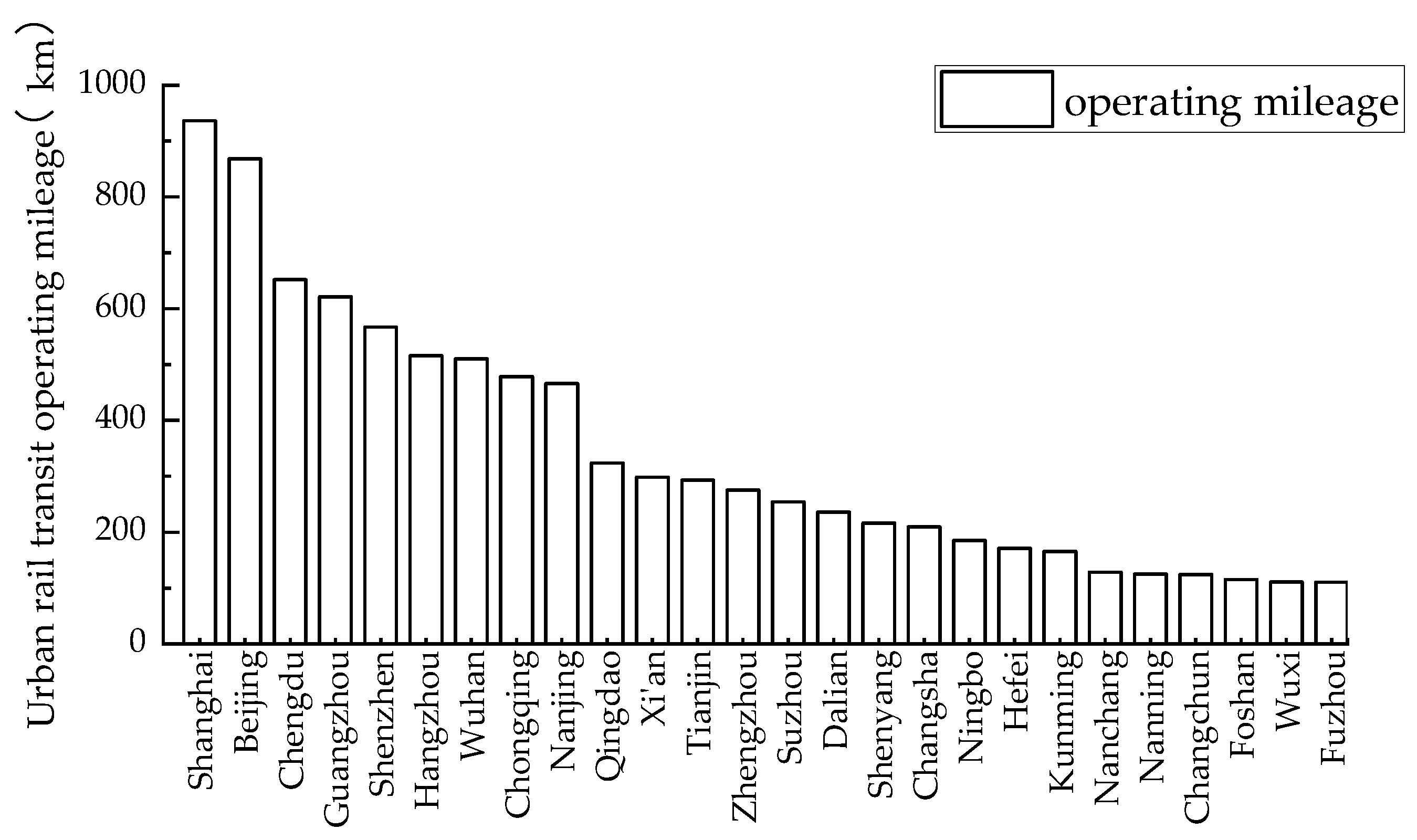


| Construction Method | Overview of the Method | Sketch Map |
|---|---|---|
| Space L | Urban rail transit stations are regarded as network nodes. If two stations are adjacent on a single rail transit line, there are connected edges between them. | 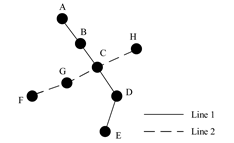 |
| Space P | Urban rail transit stations are regarded as network nodes. If the stations have a direct transportation line, there is a connection between them. | 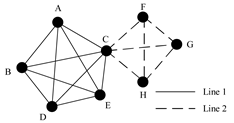 |
| Space B | The stations and lines in the urban rail transit network are regarded as network nodes and the nodes abstracted as a line have connected edges with any station node on the line. | 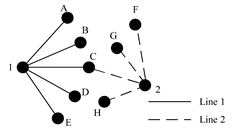 |
| Space C | The lines in the urban rail transit network are regarded as the network nodes. If different lines can be reached by transfer, the abstract nodes of these lines are connected with each other. |  |
| Assessment Measure | Sketch Map | Formula | ||
|---|---|---|---|---|
| quantitative assessment | Based on the resilience performance curve | Resilience triangle |  | |
| Performance integral ratio | 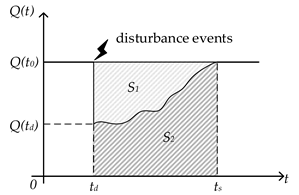 | |||
| Decrease ratio | 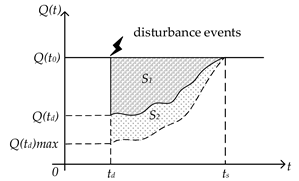 | |||
| Based on the resilience performance characterization | Ability to adapt, absorb, and recover | — | ||
| Ability to recovery and absorb | — | |||
Disclaimer/Publisher’s Note: The statements, opinions and data contained in all publications are solely those of the individual author(s) and contributor(s) and not of MDPI and/or the editor(s). MDPI and/or the editor(s) disclaim responsibility for any injury to people or property resulting from any ideas, methods, instructions or products referred to in the content. |
© 2024 by the authors. Licensee MDPI, Basel, Switzerland. This article is an open access article distributed under the terms and conditions of the Creative Commons Attribution (CC BY) license (https://creativecommons.org/licenses/by/4.0/).
Share and Cite
Hu, J.; Yang, M.; Zhen, Y. A Review of Resilience Assessment and Recovery Strategies of Urban Rail Transit Networks. Sustainability 2024, 16, 6390. https://doi.org/10.3390/su16156390
Hu J, Yang M, Zhen Y. A Review of Resilience Assessment and Recovery Strategies of Urban Rail Transit Networks. Sustainability. 2024; 16(15):6390. https://doi.org/10.3390/su16156390
Chicago/Turabian StyleHu, Junhong, Mingshu Yang, and Yunzhu Zhen. 2024. "A Review of Resilience Assessment and Recovery Strategies of Urban Rail Transit Networks" Sustainability 16, no. 15: 6390. https://doi.org/10.3390/su16156390






